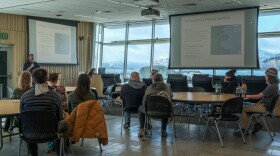Researchers are monitoring a bloom of phytoplankton near one of Kodiak Island’s beaches that is known to cause paralytic shellfish poisoning, or PSP. PSP can be dangerous and even fatal, and locals have been once again cautioned against consuming wild shellfish.
On May 30 the environmental team with the Kodiak Area Native Association [KANA] announced they had discovered an Alexandrium bloom at South Trident Basin on Near Island. Alexandrium catenella is the phytoplankton responsible for paralytic shellfish poisoning.
Kasey Jo Wright is the researcher who detected the bloom at Trident Basin. She said something was off when she was taking her weekly water sample on May 29, specifically the turbidity or clarity of water was higher than average.
“The water that day, there was a thickness of pigment in it. It was more opaque than usual, which is letting me know that there is a larger quantity of phytoplankton in the water,” Wright explained.
A higher concentration of phytoplankton can be evident by a changing of the water color. For example, the prominent red tide, or harmful algal bloom that results in water turning blood red. But this does not necessarily mean that Alexandrium catenella is present in the water; a change in water color could be due to another type of phytoplankton or algal bloom.

KANA’s environmental team has sent shellfish tissue samples to the lab in Sitka, Southeast Alaska Tribal Ocean Research or SEATOR for PSP testing, but as of June 5, has not heard back the results.
Wright said it’s unclear exactly when the local bloom happened. It could have been any day between her samples during the last week of May, on May 22 and May 29. She suspects though, based on the concentration of phytoplankton, that the bloom started in South Trident Basin a day or two before her sample on May 29.
Trident Basin is the only beach, out of the three main areas where she regularly takes water samples, that an Alexandrium bloom was discovered.
Aside from water samples, Wright and the KANA environmental team also take tissue samples from shellfish, mainly blue mussels, on three different beaches - Trident Basin, Mission Beach, and Frye Point. That’s because a blue mussel is the best local species of shellfish available to indicate whether or not nearby algal blooms are producing toxins like PSP.
“The reason why we monitor them is because they have a short turnaround time for toxin release," Wright said. "So the blue mussels that we will harvest from South Trident Basin, when we get these results back, we’re going to see how much toxin they absorbed from this event.”
The other species of shellfish that are typically found around Kodiak Island beaches include butter clams, mussels, and razor clams.
KANA urges caution before eating any species of shellfish around the island, as it is difficult to know how long each individual species will hold toxins in its system. KANA is not a regulatory agency; however, it says the consumption of wild shellfish in Alaska is considered ‘dig at your own risk’.
Local subsistence harvesters can submit a sample of their shellfish to KANA for free PSP testing through the Harvest and Hold Program. Contact the environmental team for more information via email at environmental@kodiakhealthcare.org or 907-486-1362.
“We know that this program works and is able to provide information for folks. And that’s kind of an example of someone that utilizes the program recently and we definitely called them and said ‘this is not advised to consume these shellfish,’" Andie Wall, KANA's environmental programs supervisor, said. "KANA is not a regulatory agency. That is not the role that we fit into, but we are there to provide information for people to make informed decisions."
Wall said KANA tries to have test results from harvested shellfish turned around within 48 hours but that timeframe can vary. She said no one has submitted shellfish that were impacted by the South Trident Basin bloom to her team so far. But residents have submitted shellfish from other areas of the island for the Harvest & Hold testing within the past week or so.
If anyone experiences PSP symptoms, including numbing of arms and legs, nausea, and or difficulty breathing, seek medical attention immediately.




